|
February 2015
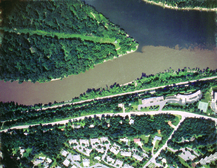 The Minnesota Pollution Control Agency (MPCA) is nearing completion of revising the draft Total Maximum Daily Load (TMDL) report for the South Metro Mississippi total suspended solids impairment. (Photo at right shows plume of sediment entering the Mississippi from the Minnesota River.) The revisions are based on comments received during the 2012 public notice period and follow-up communication with stakeholders.
In addition to more than 400 comments, the agency received requests for contested case hearings from the following entities:
- City of Minneapolis;
- Minnesota Cities Stormwater Coalition / League of Minnesota Cities;
- Lower Minnesota River Watershed District;
- Minnesota Soybean Growers Assoc., Brown County Corn and Soybean Growers, and several individual producers; and
- Lake Pepin Legacy Alliance.
The city of Minneapolis and the Minnesota Cities Stormwater Coalition / League of Minnesota Cities have withdrawn their hearing requests. The agency continues discussions with some of the other parties on their requests. If not withdrawn, MPCA Commissioner John Linc Stine will decide whether to grant or deny them after a review by the Minnesota Attorney General’s office.
Depending on the status of requests for contested case hearings, the revised TMDL could go to the U.S. Environmental Protection Agency in 2015 for final approval.
|
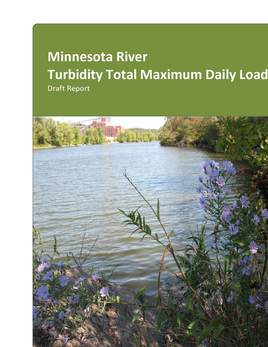 The MPCA is making significant revisions to the draft TMDL report for the Minnesota River turbidity/total suspended solids impairment. The changes include an appendix on replacing the turbidity standard with the newly adopted total suspended solids standard. Other changes address concerns from entities with municipal separate storm sewer systems (MS4 permits).
When revisions are complete, the MPCA plans to place the draft report on public notice again.
During the first public notice period in 2012, the MPCA received about 320 comments, several requests for contested case hearings, and two petitions to address the MPCA Citizens Board. During the second public notice period, commenters may maintain their requests, withdraw them, or revise them.
The MPCA will announce the second public notice in the State Register and agency newsletters as well as on its website and through media releases.
|
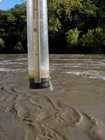 The MPCA is waiting for the Minnesota Attorney General’s Office to review contested case hearing requests for the draft TMDL report for the Greater Blue Earth River turbidity impairment. After this review, Commissioner Stine will decide whether to grant or deny the requests.
During the 2012 public notice period, the MPCA received several requests for contested case hearings; one petition to address the MPCA Citizens Board; and three comments. Several legal challenges have delayed action on this TMDL report.
Photo at right shows turbidity monitoring in the Blue Earth River near Mankato.
|
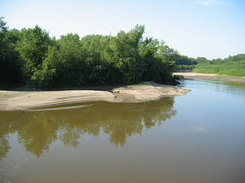
While the MPCA continues revisions to TMDL studies for the
Minnesota River and South Metro Mississippi, the agency and local partners are
moving forward with a strategy to
reduce sediment in these major rivers.
High levels of suspended sediment flow through the Minnesota
River and the South Metro portion of the Mississippi River. Excess sediment —
primarily clay and silt — contributes to cloudy, murky water, which degrades
habitat for fish and aquatic life, and lowers the aesthetic quality of our
rivers for recreation and tourism.
The MPCA has developed a general strategy that focuses on
strategies and actions that can be used to help achieve local sediment
reduction goals. It acknowledges the complexity of land use and geographical
issues facing sediment reduction goals.
Sediment
reduction goals
The strategy proposes interim targets that include a 25 percent
reduction by 2020 and a 50 percent reduction by 2030. A 90 percent reduction
from the current sediment loading is needed to meet the Minnesota River
sediment TMDL by 2040. The South Metro Mississippi River sediment TMDL requires
a 50 percent reduction from current sediment loading.
Significant changes in policy, technology, and the science
behind these issues are expected over this 25-year period. Because these
changes may influence planning efforts in unforeseen ways, a focus on meeting
shorter-term goals will help ensure that each step of the implementation
process is based on current data and information.
The MPCA determined the goals from TMDL studies for sediment in
the two rivers. The studies focus on achieving the level of nutrients, or load,
that the rivers can accept and still meet state water quality standards for
aquatic recreation. The TMDLs are part of a nationwide effort under the federal
Clean Water Act to identify and clean up pollution in streams, rivers and
lakes. Throughout the studies, the MPCA is working with local partners to
develop plans to reduce the pollutants.
Sources
of sediment
Because the majority of the suspended sediment load in the South
Metro Mississippi River comes from the Minnesota River, efforts in the
Minnesota River basin directly affect downstream areas. Sediment erosion in the
Minnesota River Basin and its tributaries comes from four main sources:
-
Bluffs and streambanks;
- Uplands — surface erosion from areas of exposed soil;
- Urban areas and other developed land uses;
- Ravines and gullies.
According to several scientific studies, the greatest
contributors to increased sediment in the Minnesota River are ravines, bluffs
and streambanks, often referred to as “near-channel sources.”
The strategy emphasizes the importance of citizen involvement in
setting short- and long-term goals, tracking progress, and adapting to future
research and monitoring.
Regardless of the main cause or causes, many of the solutions
are the same. They can range from traditional conservation practices that
reduce soil erosion on cropland, to innovative practices and programs that
increase water storage on the land.
Public comments and responses
The MPCA recently finalized the Sediment
Reduction Strategy document, which is posted online. The 25 comments
received during the 2014 public notice are also published online, along with
the agency’s
responses.
|

(Editor's note: Although the TMDL reports for the South Metro Mississippi, Minnesota and Greater Blue Earth rivers are still in draft form, work to reduce the sediment loads in these river systems continues to progress at several levels, as demonstrated in the stories below.)
About 300 people attended one of two presentations Jan. 20-21 by Dr. Peter Wilcock on "Sediment, science, and stakeholders - clearing the muddy waters of the Minnesota River." Dr. Wilcock, who now heads the Dept. of Watershed Sciences at Utah State University, presented a clear and thorough summary of the vast research so far on sediment in the Minnesota River. For many years he has been among the leading scientists working on the Minnesota River.
"The Minnesota River basin presents a great opportunity to solve the great challenge of non-point source pollution," he says. This is due to the coinciding factors of the basin's distinctive geology, uniform land use, and the fact that it lies mostly within Minnesota. The state has strong conservation values backed by real commitment to action such as the Clean Water Legacy amendment, the latter being 'unusual behavior' among states, he says. "If we can't solve the non-point source problem in the Minnesota River basin, I'm not sure where we can." Dr. Wilcock emphasized the importance of using science to support decision-making. "The watershed is complex, but if we take a balanced approach to all the evidence, we can provide clear guidance for the hard decisions and big investments needed to reduce turbidity in the Minnesota River."
Basin geologically vulnerable to erosion
The Minnesota River basin is geologically vulnerable to erosion. However, a combination of more intense precipitation, increased artificial drainage, and more row crops - particularly soybeans - have greatly increased flows and sediment loads, beyond natural background conditions. While questions remain, the evidence so far is clear. A majority of the sediment comes from near-channel sources. This is evident in the 'sediment budget' developed for the LeSueur River and Blue Earth River, Minnesota River tributaries that contribute disproportionately large amounts of sediment. The solutions lie in measurable actions to store more water higher in the watershed, and stabilize bluffs and banks that threaten to collapse under buildings and bridges.
Following the presentation in St. Paul, a panel of experts joined Wilcock to answer questions from the audience: Carrie Jennings, Shawn Schottler, and Paul Nelson. Wilcock noted that more information is available in the publication, "Identifying sediment sources in the Minnesota River Basin." A recording of the St Paul event is available at freshwater.org, the website of the Freshwater Society, which sponsored the events at the U of M-St. Paul, and City Center Hotel in Mankato.
|
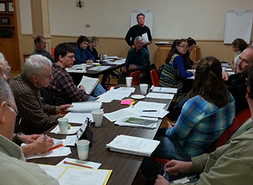 A group of volunteers met Tuesday, Jan. 27 at the Henderson Community Center to begin working on organizing principles, studying summaries of the previous two Minnesota River congress events, and drafting mission and vision statements for a Minnesota River organization. These will be developed as recommendations for discussion and voting at a third congress in late March or early April.
More than 20 people from various organizations and interests volunteered to serve on an organizing team. At the Jan. 27 meeting they worked on crafting mission and vision statements that embody the purpose of a basin-wide organization. They also favored a name change, such as Minnesota River Council. The organizing team will meet again in February at Henderson. Final decisions will be made by all participants at the next full congress meeting.
Organizers believe there’s a need for a citizen-led entity that is inviting and all inclusive for the many different groups active in the Minnesota River Valley, including agriculture, industry, natural resources, recreation, economic development, tourism, all levels of government, faith communities, first nations, and watershed organizations. Top actions and initiatives identified at the congress meeting included: Political action or lobbying, conservation actions, communication, and education. For more information, contact Scott Sparlin, 507-276-2280, yasure@lycos.com; or Ted Suss, (507) 828-3377, tedsuss@gmail.com. Photo: Planning committee meeting Jan. 27 at the Henderson Community Center.
|

The Legislative-Citizen
Commission on Minnesota Resources is accepting proposals through May 11 for
grants from the Environment and Natural Resources Trust Fund, which is funded
with Minnesota Lottery and investment proceeds. The commission expects that
$46.3 million will be available for projects that start in July 2016.
The commission is responsible for
making funding recommendations to the Minnesota Legislature. (The 2015
Legislature will vote on recommendations for proposals received last year.)
Projects are
being sought in the following areas:
-
Foundational natural resource data and information;
- Water resources;
- Environmental education;
- Aquatic and terrestrial invasive species;
- Air quality, climate change, and renewable energy;
- Methods to protect or restore land, water, and habitat and
- Land acquisition for habitat and recreation.
The intent of this
funding program is to provide access to everyone for innovative ideas for
environmental or natural resource projects that could provide multiple ecological
and other public benefits to Minnesota. Projects must be consistent with the
commission’s Six‐Year
Strategic Plan for the trust fund and the adopted funding priorities described
in the RFP.
The full Request for
Proposals is available on the commission’s
website.
|
MPCA public information officers Cathy
Rofshus and Forrest Peterson are planning to merge this newsletter, “River
Connections,” with “Watershed Network News” for a new publication called “Watershed
Connections.” The two newsletters currently overlap in topics and geographical focus,
with both of them highlighting work in the Minnesota River Basin, including the
Greater Blue Earth River, and the impacts downstream to the Mississippi.
The information officers believe this
merger will offer more efficiency while increasing the readership of
information about these important river systems.
They expect to launch Watershed
Connections in March. This newsletter will still be published via a monthly
email. Please note that the two subscription lists will be combined. If you
prefer to not be included, click the “unsubscribe” link below to change your
settings. If you have questions or comments, please contact Cathy or Forrest at
the emails or phone numbers below.
We thank you for reading River Connections
and hope you find the new publication useful.
|